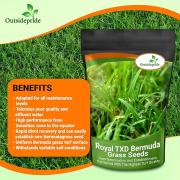If a tan, dormant lawn in the winter is more than you can bear, you might want to consider over seeding your Bermuda grass lawn with a cool season grass. The cool season grass will germinate in the fall and begin to grow as your Bermuda grass is going dormant. As spring arrives your Bermuda grass will begin to green as normal. During this "spring transition" the over seeded grass and Bermuda grass will both be alive and will be competing with one another. As the heat of summer arrives, though, the over seeded grass will die and leave the Bermuda grass to prosper for the rest of the summer.
Bermuda grass can be over seeded with a variety of cool season grasses. The key is to choose one that will not last too long into summer, thus competing with your Bermuda grass. Annual ryegrass is a good, generic choice for the South. It cannot tolerate hot weather and will die quickly as heat approaches. Perennial ryegrass can be used in the low South although it lingers too long into summer in areas where fescue grows well. Creeping Bentgrass is another choice, but it is expensive and is seldom available. Do not over seed Bermuda grass with Tall Fescue or Kentucky Bluegrass since they will last well into summer and compete with your Bermuda grass.
Steps in Over seeding Bermuda Grass
- Do not apply pre-emergence weed control in the three months prior to over seeding
- Over seed Bermuda grass lawns when the soil temperature drops to 70°. This is usually around September 15 in the upper South and October 15 in the lower South.
- Prepare the lawn before seeding by mowing your Bermuda grass about 1 inch and by raking the lawn vigorously with a metal tined rake.
- Sow 6-8 pounds of Annual Ryegrass per 1000 square feet and broadcast a complete lawn fertilizer than contains a slow release form of nitrogen, if you have not done so already. Apply at the rate of 1.5 pounds of actual nitrogen per 1000 square feet.
- Keep the soil surface moist for 7-10 days to ensure even germination. After that, water weekly if there has been no significant rainfall.
- Begin mowing as soon as the Annual Ryegrass reaches 2.5 inches. This is a good time to install a new mower blade, or sharpen the old one. A dull blade will rip seedlings from the lawn.
- Continue to mow throughout the winter at 2 inches, whenever the grass reaches 3 inches
- Fertilize lightly every 4-6 weeks throughout the winter whenever the Annual Ryegrass is light green. Use a fertilizer like 10-10-10 that contains a soluble form of nitrogen, not a slow release form of nitrogen. Slow release forms of nitrogen are not effective during winter cold. Apply at the rate of .5 pound of actual nitrogen per 1000 square feet. If using 10-10-10, this equals 5 pounds per 1000 square feet. Stop fertilizing in February, however, to slow its growth so it will not compete with your Bermuda grass during the spring green up.
- In March, now your lawn below 1 inch as described in the mowing section. This will shock the Annual Ryegrass and give the Bermuda grass a change to emerge. The remaining Annual Ryegrass will die once warm weather arrives.




































